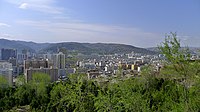Tianshui
天水市 | |
|---|---|
Tianshui Fuyi pedestrian street (top), Tianshui skyline | |
 Location of Tianshui City jurisdiction in Gansu | |
| Coordinates (Tianshui municipal government): 34°34′53″N 105°43′29″E / 34.5815°N 105.7248°E | |
| Country | People's Republic of China |
| Province | Gansu |
| Municipal seat | Qinzhou District |
| Area | |
| 14,280 km2 (5,510 sq mi) | |
| • Urban | 5,866 km2 (2,265 sq mi) |
| • Metro | 5,866 km2 (2,265 sq mi) |
| Elevation | 1,171 m (3,842 ft) |
| Population (2020 census)[1] | |
| 2,984,659 | |
| • Density | 210/km2 (540/sq mi) |
| • Urban | 1,212,791 |
| • Urban density | 210/km2 (540/sq mi) |
| • Metro | 1,212,791 |
| • Metro density | 210/km2 (540/sq mi) |
| GDP[2] | |
| • Prefecture-level city | CN¥ 55.4 billion US$ 8.9 billion |
| • Per capita | CN¥ 16,743 US$ 2,688 |
| Time zone | UTC+8 (China Standard) |
| Postal code | 741000 |
| Area code | 0938 |
| ISO 3166 code | CN-GS-05 |
| Licence plate prefixes | 甘E |
| Website | tianshui |
| Tianshui | |||||||||
|---|---|---|---|---|---|---|---|---|---|
 The entrance to the Fuxi Temple in Tianshui | |||||||||
| Chinese | 天水市 | ||||||||
| Postal | Tenshui | ||||||||
| Literal meaning | City of Sky and Water | ||||||||
| |||||||||
| Qinzhou | |||||||||
| Chinese | 秦州 | ||||||||
| Postal | Tsinchow | ||||||||
| Literal meaning | Qin Province | ||||||||
| |||||||||
| Tianshui Commandery | |||||||||
| Chinese | 天水郡 | ||||||||
| Literal meaning | Commandery of Heaven and Water | ||||||||
| |||||||||
| Hanyang Commandery | |||||||||
| Simplified Chinese | 汉阳郡 | ||||||||
| Traditional Chinese | 漢陽郡 | ||||||||
| |||||||||
| Hanyang County | |||||||||
| Simplified Chinese | 汉阳县 | ||||||||
| Traditional Chinese | 漢陽縣 | ||||||||
| |||||||||
Tianshui is a prefecture-level city in Gansu province, China, and is the province's second-largest city (behind the provincial capital Lanzhou). Located in the southeast of the province, the city strides along the upper reaches of the Wei River and at the boundary of the Loess Plateau and the Qinling Mountains. As of the 2020 census, its population was 2,984,659 inhabitants, of which 1,212,791 lived in the built-up (or metro) area made of the 2 urban districts of Qinzhou and Maiji.[1] The city and its surroundings have played an important role in the early history of China, as still visible in the form of historic sites such as the Maijishan Grottoes.
- ^ a b "China: Gānsù (Prefectures, Cities, Districts and Counties) - Population Statistics, Charts and Map". www.citypopulation.de.
- ^ 甘肃省统计局、国家统计局甘肃调查总队 (November 2016). 《甘肃发展年鉴-2016》. 中国统计出版社. ISBN 978-7-5037-7894-0.



